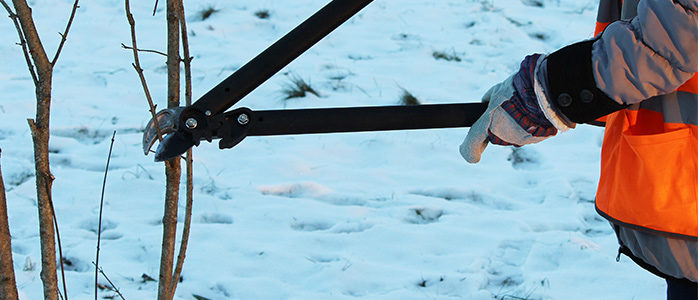If you’re not a fan of yardwork, winter can be a vacation of sorts. Sure, there is the matter of shoveling the driveway, but you also get up to six months free of lawn-mowing, weed-picking, and tree-trimming!
That said, you shouldn’t ignore trimming trees and shrubs in winter (even if you can’t always see them underneath all that snow.) Here’s why.
No Insects or Disease
We forgot to add this one to the list of winter benefits: no insects! In addition to being persistent annoyances, bugs also invade plants via the cuts you make when pruning during the warmer months.
Diseases can also enter a tree or shrub via your trims, but these fungal and bacterial menaces are dormant during the wintertime. Certain diseases are quite virulent; pruning when it’s warm out increases the risk of spreading. You can even carry them from one plant to another on your pruning tools.
Easy Identification of Ailing Branches
With the greenery gone for the winter, one can more easily spot areas that need attention (once you brush off the snow, that is) and avoid accidentally severing healthy branches. You can clearly see sickly branches that overlap with healthy ones. Understory plants are also less likely to suffer undue harm in the process.
Safety
Trimming dead branches makes your property safer. This is especially true in the winter due to snow and ice accumulation following storms. Remove dead branches near sidewalks and driveways before they become an unintentional hazard. You can also alter the remaining branch areas into shapes that will better handle the extra load.
Wait until the branches thaw before cutting. Trying to smash ice off frozen branches will only result in breaking them. It is also a good idea to straighten out the branches as best you can to prevent them remaining in that shape.
Maximize Output
The output of certain trees (eg. apple) benefits from winter pruning because the damage is all healed before the growing season begins. Branches trimmed this time of year also heal faster and that means less sap loss.
Less Disruption of a Tree’s Natural Functions
During the colder months, trees store most of their carbohydrates and nutrients in the roots. Winter trimming has far less impact on the tree’s energy supply.
Fewer Leaves
If you trim your tree during the colder months, it produces fewer leaves come springtime. This sounds like a bad thing but it is actually a benefit. Since the tree will have less top growth, it will thrive on less water and fewer nutrients.
Frozen Ground Will Better Support Equipment
If you require equipment to reach the higher branches on your trees, the frozen winter ground will support it more effectively than the softer soil of spring, summer, and fall.
Less Work for You in the Springtime
There are many things you must do in the yard once the snows of winter finally retreat. Getting your pruning done ahead of time means more time available for you to concentrate on tasks that are not possible in winter.
Winter Exercise
If you are the type whose exercise level dips this time of year, a little yard work will help to keep you active and fit. Your time in front of the fireplace that evening will be even more satisfying!



